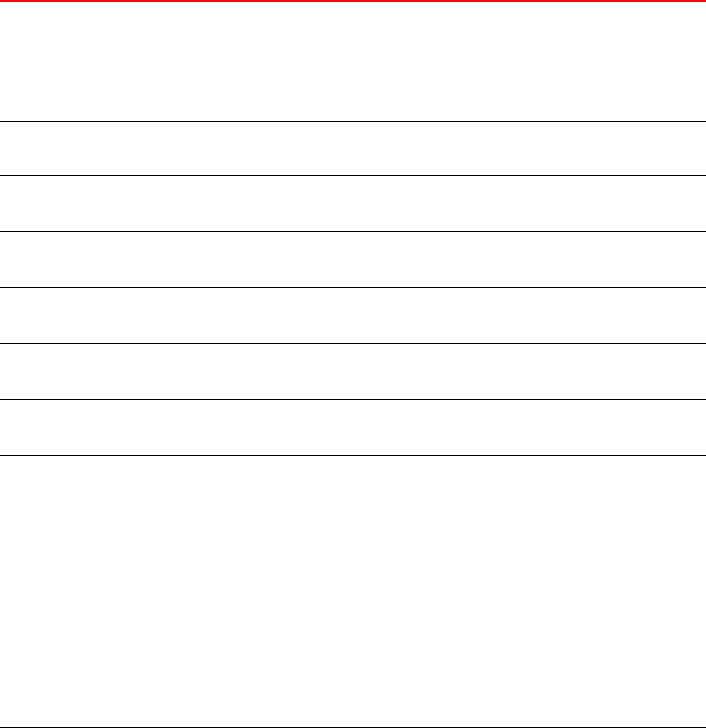Network Router User Manual
Table Of Contents
- About This Document
- Introduction
- Common Commands
- In this chapter
- Common commands
- show
- autoinstall
- banner
- commands
- crypto
- environment
- history
- interfaces
- ip
- ldap
- licenses
- logging
- mac
- mac-address-table
- management
- mobility
- ntp
- port-channel
- power
- privilege
- radius
- redundancy dynamic-ap-load-balance
- redundancy group
- redundancy history
- redundancy members
- rtls
- smtp-notification
- snmp
- snmp-server
- spanning-tree
- static-channel-group
- terminal
- timezone
- traffic-shape
- users
- version
- wireless
- (config-wireless) Executable Mode
- wlan-acl
- access-list
- aclstats
- alarm-log
- boot
- clock
- debugging
- dhcp
- file
- ftp
- password-encryption
- running-config
- securitymgr
- sessions
- startup-config
- upgrade-status
- mac-name
- firewall
- role
- virtual-IP
- wwan
- aap-wlan-acl
- aap-wlan-acl-stats
- protocol-list
- service-list
- User Exec Commands
- Privileged Exec Commands
- Global Configuration Commands
- In this chapter
- Global Configuration commands
- aaa
- access-list
- autoinstall
- banner
- boot
- bridge
- country-code
- crypto
- do
- end
- errdisable
- ftp
- hostname
- interface
- ip
- license
- line
- local
- logging
- mac
- mac-address-table
- mac-name
- management
- ntp
- prompt
- radius-server
- ratelimit
- redundancy
- role
- rtls
- service
- smtp-notification
- snmp-server
- spanning-tree
- timezone
- traffic-shape
- username
- vpn
- wireless
- wlan-acl
- network-element-id
- firewall
- virtual-ip
- wwan
- aap-wlan-acl
- arp
- power
- aap-ipfilter-list
- whitelist
- Crypto-isakmp Instance
- Crypto-group Instance
- Crypto-peer Instance
- Crypto-ipsec Instance
- Crypto-map Instance
- Crypto-trustpoint Instance
- Interface Instance
- Spanning tree-mst Instance
- Extended ACL Instance
- Standard ACL Instance
- Extended MAC ACL Instance
- DHCP Server Instance
- DHCP Class Instance
- Radius Server Instance
- Wireless Instance
- In this chapter
- Wireless configuration commands
- aap
- admission-control
- adopt-unconf-radio
- adoption-pref-id
- ap
- ap-containment
- ap-detection
- ap-image
- ap-ip
- ap-standby-attempts-threshold
- ap-timeout
- ap-udp-port
- auto-select-channels
- broadcast-tx-speed
- client
- clrscr
- cluster-master-support
- convert-ap
- country-code
- debug
- dhcp-one-portal-forward
- dhcp-sniff-state
- dot11-shared-key-auth
- end
- exit
- fix-broadcast-dhcp-rsp
- help
- hotspot
- load-balance
- mac-auth-local
- manual-wlan-mapping
- wireless-client
- mobility
- multicast-packet-limit
- multicast-throttle-watermark
- nas-id
- nas-port-id
- no
- proxy-arp
- qos-mapping
- radio
- rate-limit
- secure-wispe-default-secret
- self-heal
- sensor
- service
- show
- smart-rf
- smart-scan-channels
- wlan
- wlan-bw-allocation
- dot11k
- wips
- non-preferred-ap-attempts-threshold
- test
- RTLS Instance
- ESPI Instance
- RFID Instance
- SOLE Instance
- Smart RF Instance
- Role Instance
- AAP IP Filtering

650 Brocade Mobility RFS4000, RFS6000 and RFS7000 CLI Reference Guide
53-1001931-01
Wireless configuration commands
20
base-bridge [enable|
max-clients <1-12>]
Sets base bridge values
• enable – Allows the given radio to act as a base bridge and
accept connections from client bridges.
• max-clients <1-12> – Configures a base-bridge. Enter
maximum client bridges allowed.
beacon-interval
<50-200>
Sets the beacon interval (in K-uSec)
bridge-fwd-delay <4-30> Sets the STP bridge forward delay (in seconds)
• <4-30> - Time in seconds
bridge-hello <1-10> Sets the STP bridge hello (in seconds)
• <1-10> - Time in seconds
bridge-max-ageout
<4-3600>
Sets the STP bridge maximum ageout (in seconds)
• <4-3600> - Time in seconds
bridge-msg-age <6-40> Sets the STP bridge message age (in seconds)
• <6-40> - Time in seconds
bridge-priority
<0-65535>
Sets the STP bridge priority (in seconds)
• <0-65535> - Priority value
bss [<1-4>|add-wlans|
auto] <wlans>
Maps WLANs to radio BSSIDs
• <1-4>– Sets the BSS where WLANs are mapped
• add-wlans <wlans> – Adds new WLANs to existing radios.
The other WLANs on the radios are left as is.
• auto <wlans> – Sets the automatic assignment of a BSS. The
user selects WLANs, and the system assigns them to a BSS
automatically.
• <wlans> – Defines a list (1,3,7) or range (3-7) of WLAN
indices. When a BSS is also specified, the first WLAN is used
as the primary WLAN. When the auto option is used, the
system automatically assigns the first four WLANs as
primaries on their respective BSSIDs.
channel-power
[indoor|outdoor]
[<1-200>|acs|random]
Sets the location, channel and transmit power level
• indoor [<1-200>|acs|random]– Defines an indoor location
• <1-200> <4-20> {[lower|upper]} – Defines the channel
number
• <4-20> – Power in dBm
• lower – Lower channel width mode
• upper – Upper channel width mode
• outdoor [<1-200>|acs|random]– Defines an outdoor
location
• <1-200> – Sets the channel number
• <4-20> – Sets the power in dBm
• acs <4-20> {[20 MHz | 40 Mhz]} – Enables ACS (auto
channel selection). A radio will scan for the least
congested channel at startup or controller
reconfiguration.
• random <4-20> {[20 MHz | 40 Mhz]} – Random
channel selection










